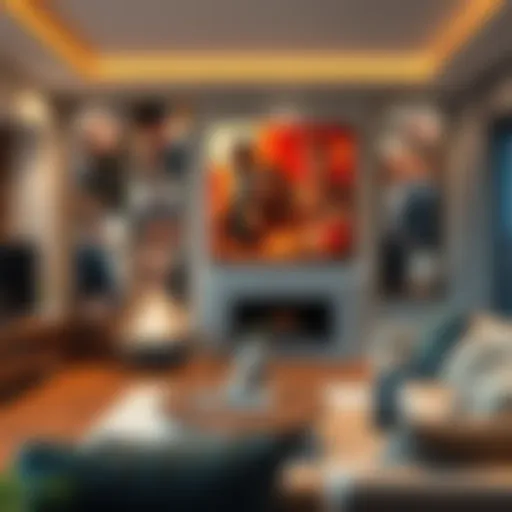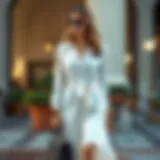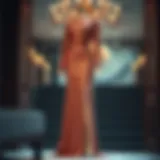Enhancing Curtains with Rope: Aesthetic and Practical Insights
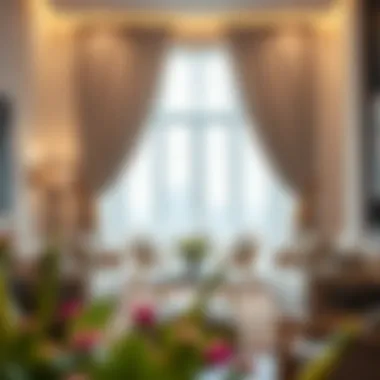

Intro
Harnessing the natural allure of rope for curtain styling may not seem like a typical solution amidst a world of sophisticated curtain hardware and elaborate drapery. Nonetheless, there lies an engaging intersection of practicality and aesthetic allure when it comes to using rope to tie curtains. This approach not only offers a rustic, organic feel to any space but also allows for creative expressions of personality through various knot techniques and materials.
Rope comes in many forms, from jute to cotton and even synthetic blends, presenting an array of choices that can enhance the overall decor of a room. Saving money without sacrificing style is something both designers and homeowners cherish.
In a nutshell, utilizing rope as a tool for enhancing curtain functionality and aesthetics marries form and function like few other methods can. This guide will empower you with the insights you need to navigate the ropes—pun intended—whether you're dressing up windows in a sleek urban loft or bringing a cozy touch to a country cottage.
Practical Applications
While the aesthetic appeal is noteworthy, it's the practical applications that will draw you in further. Rope provides functionalities far beyond just being a stylish accessory. Here's a deep dive into how you can seamlessly integrate rope into your curtain styling:
- Easy Adjustments: Tying curtains with rope allows you to easily adjust the opening and closing of curtains according to your preference. This adaptability can be quite handy, particularly in spaces where controlling light and privacy is paramount.
- Space Enhancement: For smaller rooms, using rope can draw the eye upward, creating the illusion of height. This is especially advantageous in rooms where space is a concern.
- Durability: Many types of rope are designed to withstand wear and tear, ensuring your curtain ties remain functional for a long stretch of time, adding great value to your decorating efforts.
Types of Rope for Curtain Tying
When exploring the subject, knowing the different types of rope that can be used is essential. Each type serves a specific purpose and comes with its own set of qualities:
- Jute Rope: This natural fiber is sturdy yet soft, making it visually appealing and comfortable to the touch.
- Nylon Rope: Known for its strength and resilience against weather, this synthetic option holds up well in high humidity areas like kitchens and bathrooms.
- Cotton Rope: This material blends beautifully with various decor styles, lending a zen-like quality that many find calming.
Aesthetic Considerations
Integrating rope into your curtain styling isn’t just about functionality; it's also about creating an inviting environment that speaks to your personal taste. A carefully chosen rope can complement the fabric of your curtains and other elements in the room:
- Color Coordination: Consider the colors in your space when selecting rope. For a cohesive look, pick a rope that harmonizes with your color scheme.
- Texture Play: The texture of the rope can contrast or blend with the fabric of your curtains, enhancing depth in your decor.
- Knot Techniques: The way you tie your curtains can affect the overall ambiance. Explore different knots such as a simple knot, bow, or even a decorative sailor's knot to find what best suits your style.
"Rope with character brings a touch of warmth that polished metal or plastic just can’t replicate."
The End
By experimenting with various rope types and techniques, you can effectively create an enchanting arrangement that accentuates your living space. The combination of functional elegance and personal style that rope provides speaks to a timeless aesthetic that appeals to many tastes. Whether you're a seasoned designer or a freshly budding enthusiast, there’s always room to innovate with rope in curtain styling. As you embark on your journey of incorporating this unique element into your home, keep in mind the harmonious balance of practicality and visual ease.
Preface to Rope and Curtains
Exploring the concept of tying curtains with rope offers a rich tapestry of creativity and practicality in interior design. The act of tying curtains is not merely functional; it intertwines with the aesthetics of a space. Rope, in this context, is a versatile tool that can dramatically alter the ambiance of a room, inviting a blend of rugged simplicity and refined elegance. This introduction aims to set the stage by highlighting the significance of using rope in curtain tying, the multiple benefits it brings, and the considerations one must take into account.
Tying curtains with rope is meaningful in several ways. It can be a practical solution to control light and privacy. By adjusting how tightly or loosely the rope is tied, one can create a spectrum of atmospheres—from cozy and intimate to bright and open.
Moreover, the choice of rope can greatly influence the aesthetic of a space. Natural materials like jute or sisal evoke warmth and earthiness, which may be perfect for rustic or bohemian styles. In contrast, synthetic ropes can project a modern vibe, aligning with minimalistic or contemporary decor.
"The right rope can enhance a room's character, turning ordinary curtains into statement pieces."
As we delve into the historical outlines and developments of curtain tiebacks, it's essential to recognize how rope has played a pivotal role. Understanding the past gives context to the present trends and can inspire innovative applications in today's decor.
Furthermore, to fully appreciate the art of tying curtains with rope, it's necessary to grasp how this simple technique can enrich not just the functionality of window treatments but the overall design ethos of a home. As we progress through this article, we will take keen observations of all these factors—historical, practical, and aesthetic—providing readers with a comprehensive overview of this compelling practice.
Types of Rope for Tying Curtains
When considering how to enhance the appearance and functionality of curtains, the choice of rope plays a pivotal role. Ropes serve not just as a binding element, but they contribute to the overall aesthetic and practical application of tying back the drapes. From creating a welcoming atmosphere to ensuring durability, understanding the various types of rope available is essential. Different materials, whether natural or synthetic, bring unique qualities that cater to varying styles and needs.
Natural Fiber Ropes
Natural fiber ropes are often favored for their organic appearance and characteristics that resonate with a range of decor styles. They lend warmth and an earthy quality to interiors, making them a popular choice among those looking to incorporate a rustic or casual vibe into their home.
Sisal
Sisal rope, derived from the agave plant, holds a distinct position in the realm of curtain tying. Known for its robustness, it offers a unique texture that can immediate deepen the visual interest of a room. The key characteristic of sisal is its natural stiffness, which maintains its shape well when tied, holding curtains neatly without sagging.
However, it is crucial to consider that while sisal provides durability and a rustic charm, it can be prone to fraying at the edges, particularly with frequent handling. Such wear might necessitate occasional replacement, thus it can be seen as a balance of visual appeal versus maintenance needs.
Jute
Another natural option is jute, typically recognized for its softness and flexibility. It's often lauded for its biodegradability, aligning well with eco-conscious home decor choices. The key trait of jute is its light weight, which allows it to be easily manipulated into various knotting styles without causing strain to the curtains.
Yet, jute has a tendency to fade if exposed to direct sunlight for too long. This aspect may lead to a compromise in how jute enhances a space over time, making it a solid choice for shaded interiors or decorative uses.
Hemp


Hemp is increasingly recognized for its sustainability and strength. It offers robustness similar to sisal while presenting a softer texture that can complement a clean, modern look. The standout feature of hemp is its resistance to mold and mildew, making it particularly suitable for areas with increased humidity.
The downside here, however, relates to its cost; hemp rope can be more expensive than its counterparts. Yet, for those seeking an eco-friendly option, its long-lasting durability balances the initial expense, ensuring it is a wise investment.
Synthetic Fiber Ropes
On the other end of the spectrum, synthetic fiber ropes are engineered for resilience and stability. These ropes tend to excel in durability and can often withstand harsher conditions compared to natural fibers, which makes them appealing for various environments and uses.
Nylon
Nylon rope is one of the most durable synthetics available. It's incredibly strong and often possesses considerable elasticity, so it can revert to its original shape after being stretched. This resilience contributes to its use in diverse tying techniques, offering both functionality and aesthetics.
However, its slick surface can make it a bit tricky to knot securely, so care must be taken when tying curtains. Still, it’s popular among those focused on both practical applications and a sleek, polished look.
Polyester
Polyester rope comes with similar durability benefits as nylon but offers a slightly different texture. It is less prone to shrinking and stretching than nylon, which provides a consistency that many decorators appreciate. It’s fade-resistant and works well for outdoor curtains as well; this versatility makes it a go-to choice for numerous applications.
However, polyester can be prickly on the skin, which might not be desirable for hands-on projects or frequently adjusted curtains.
Polypropylene
Polypropylene stands out for its affordability and lightweight nature. It is resistant to moisture and mildew, making it a suitable option for spaces prone to dampness. The most notable element of polypropylene is its vibrant color spectrum, giving decorators a broader range of options to coordinate with various curtain fabrics.
Yet, one must keep in mind that while lower price may be appealing, it doesn't carry the same heavy-duty strength as nylon or polyester. Therefore, it might not stand up as well under strenuous use.
Choosing the Right Rope Material
Selecting the appropriate rope for tying curtains involves weighing aesthetic desires against practical functionalities. Consider the room's environment: a humid space might benefit from hemp or polypropylene, while a more traditional setting could find organic sisal or jute enhances the decor beautifully.
Ultimately, each rope type brings its own set of pros and cons, which can align strategically with particular design goals and personal preferences. Careful consideration of these aspects leads to a well-rounded decision that marries both form and function.
Techniques for Tying Curtains with Rope
When it comes to tying curtains with rope, the techniques employed can make all the difference not just in functionality, but also in how the overall aesthetic of a space is perceived. Utilizing rope effectively can transform simple drapes into statement pieces that speak to both style and intentional design. Whether it's a casual gathering in rustic surroundings or a sophisticated corner in an urban loft, mastering these techniques adds an element of craftsmanship that many overlook.
Understanding the various methods of tying curtains can help you not only secure the fabric but also enhance the visual impact of your window treatments. The effectiveness of these methods lies in several key considerations such as ease of use, versatility across different styles, and their ability to adapt to the diverse materials that curtains are made from. An adept use of rope not only elevates the look but also ensures that functionality is maintained, allowing for easy adjustments when needed.
Basic Knotting Techniques
Before diving into more complex styles, it's essential to grasp the basic knotting techniques. These foundational skills set the stage for a variety of curtain designs.
A simple bow knot, for instance, provides a charming touch without demanding much skill. This method works particularly well with lighter fabrics, complementing airy designs in spaces like kitchens or informal seating areas. To tie a bow knot:
- Gather the curtain fabric together at the desired height.
- Wrap the rope around the gathered fabric once.
- Create a loop with one end and wrap the other end around it.
- Pull through, cinching it tightly before adjusting to your preference.
Another practical choice is the square knot, which lends itself well to thicker ropes and heavier drapes. Its secure hold makes it suitable for more formal settings.
Here’s how:
- Cross one rope end over the other to form a simple overhand.
- Take the tail that is now on top and wrap it under the other, creating a second overhand.
This knot can be adjusted to clip back curtains during the day, presenting a neat, tidy look. Basic techniques serve not just functions but also give a good starting point on which you can build style.
Advanced Wrapping Methods
Once you're comfortable with the basics, it's time to explore advanced wrapping methods that can make your curtains stand out in extraordinary ways. These techniques allow for a greater interplay of texture and depth and invite creativity into your home decor.
One such technique is the double wrap, where the rope is looped twice around the gathered curtains before tying. This gives an intricate layered effect that can be particularly stunning with a thick jute or sisal rope. The double wrap creates more volume and draws attention to the curtains, making it an excellent choice for open spaces or large windows.
Another method to consider is the braided wrap. This is a bit more labor-intensive but results in a visually intricate design. To execute this:
- Begin with three lengths of rope, tie them together at one end.
- Braid them as you would hair, wrapping around the gathered curtain fabric.
- Secure the end with a knot, ensuring a durable hold.
These techniques can be combined with simple knots for a trendy layered approach; be bold and experiment with different combinations. Advanced wrapping methods create a defining frame for your windows, transforming even simple curtain fabrics into eye-catchers.
Incorporating Decorative Elements
The beauty of using rope to tie curtains transcends just function; it also opens avenues for artistic expression. Adding decorative elements not only enhances the overall appearance but also personalizes the window treatment to align with broader themes in your interior design.


Consider embellishing your rope with floral accents. A simple cluster of dried flowers, woven into the arrangement, can offer a whimsical touch, particularly suitable for a vintage or farmhouse atmosphere. Alternatively, attach beads or shells to the rope for a bohemian vibe; the texture and colors can draw the eye and also create a conversation starter.
Here are some popular decorative elements to incorporate:
- Vintage brooches or pins as fasteners.
- Twisted fabric strips for texture contrast.
- String lights woven around the rope for a soft, ambient glow.
By being intentional with these additions, the curtains can echo the themes of the room while adding layers of visual interest. These elements allow for seasonal adjustments too; swap out floral touches in spring for warmer tones in autumn, keeping the design fresh and relevant.
Styles of Rope-Tied Curtains
The way curtains are styled has a significant influence on the overall ambiance of a space. Using rope to tie curtains adds an element of sophistication while maintaining a relaxed vibe. This section covers various styles of rope-tied curtains, shedding light on their aesthetic values and how they can enhance your interior decor. Each style presents unique advantages and visual appeal, making it easier for individuals to choose options that align with their tastes and home aesthetics.
Casual and Rustic Aesthetics
Casual and rustic aesthetics celebrate the beauty of imperfection and simplicity. Utilizing rope in this style often evokes a sense of warmth and familiarity, reminiscent of country living or rooms drenched in nostalgia. Think about a cozy cabin where the earthy tones harmonize seamlessly with natural materials.
Here are a few considerations for achieving this look:
- Material Choice: Opt for natural fiber ropes, like jute or sisal, which possess inherent textures that bring the outdoors inside.
- Knotting Techniques: Use loose knots that allow the fabric to drape comfortably. A simple bow can be very effective, providing an effortless charm.
- Complementing Elements: Balance the aesthetic by using wooden curtain rods or distressed metal hooks.
"Rustic styles breathe life into any space, weaving together comfort and artistry."
Casual styles allow for flexibility and creativity. They invite personal expression, empowering homeowners and decorators to mix and match different fabrics and textures. Add in other rustic elements like throw pillows or natural woven baskets for a cohesive look.
Modern and Minimalist Approaches
In contrast, modern and minimalist approaches advocate for simplicity and clean lines. This style often employs fewer elements to create a striking visual impact. When tying curtains with rope in minimalist settings, it’s essential to focus on function without sacrificing style.
Key points to consider include:
- Sleek Rope Options: Consider using smooth nylon or polyester ropes that come in monochromatic colors. These materials maintain a polished appearance, aligning with contemporary aesthetics.
- Tying Techniques: Straightforward and neat knots or loops can keep the focus on the curtain’s design and fabric. The goal is to create a stark yet sophisticated contrast to fabric without overwhelming it.
- Balancing Decor: Pair your rope-tied curtains with understated furniture or neutral wall colors to retain that airy openness that defines modern spaces.
Modern style is all about constraints and clarity. It shapes the home to be both elegant and functional, making it simpler for individuals to incorporate limited yet impactful decorative elements.
Bohemian and Eclectic Designs
Bohemian and eclectic designs are all about vibrant self-expression and mixing styles, patterns, and colors. Here, rope plays a versatile role in tying together different design elements, making this approach feel relaxed and inviting.
When embracing a bohemian flair with rope-tied curtains, consider:
- Vivid Ropes: Choose ropes with textured patterns or bright colors to add playful energy to the space. Options like hemp dyed in rich hues can really pop!
- Inventive Tying: Use various knots, maybe a mix of braids, to form unique draping effects. Leaving elements of the curtain flowing freely can enhance that laid-back vibe.
- Curated Decor: Play with throw blankets, layered fabric, and mismatched furniture to fully embody an eclectic design.
This approach showcases character and individuality, making homes feel lived-in and unique. Infusing personal history through various textiles and personal collections enriches spaces marked by imagination and diversity.
Practical Considerations for Using Rope
When it comes to utilizing rope for tying curtains, it’s not just about looks; practicality holds a vital role. The right considerations can make all the difference between an aesthetically pleasing setup and one that becomes a hassle. Ropes serve functional benefits while enhancing the overall appeal of a room. Let’s dive into what you need to think about.
Durability and Maintenance
Durability in any decor choice is paramount, especially when dealing with something as pivotal as window treatments. Ropes that will be tying curtains daily need to be sturdy enough to withstand strain and wear. Natural fibers like sisal, jute, and hemp can offer a rustic charm, but they may be prone to fraying or damage over time.
In contrast, synthetic ropes made from materials like nylon or polyester usually provide greater resilience. They’re resistant to rot and UV damage, ensuring they maintain their strength and color longer than most natural fibers. When choosing the rope, consider its environment. Ropes placed in humid areas might degrade faster, so if you’re dealing with a bathroom or kitchen, opt for synthetic.
“A well-chosen rope can tie more than just curtains; it can bind style to functionality.”
Aside from initial durability, maintenance is another vital factor. Cleaning techniques can differ significantly between materials. Natural fibers typically require gentler care and occasional treatments to resist mold, while synthetic ropes can often be wiped clean with a damp cloth. Think about how much time you want to invest in upkeep before making a final decision.
Safety Concerns with Rope Use
When it comes to safety, using rope to tie curtains is not without its risks. An area often overlooked is how the ropes are secured. If ropes are too loose, they can slip or fall, potentially creating a trip hazard, especially in homes with children or pets. Therefore, it’s crucial to ensure that your tying techniques create a secure hold without excessive excess.
Additionally, using ropes with rough textures or sharp edging can lead to scratches or injuries. Choosing smooth, well-crafted ropes minimizes these risks while ensuring an escape from the unpleasants of snagged clothing or skin. Always keep in mind where you are placing the curtains too; curtains near beds may pose a risk to anyone who might roll into them.
Also, consider the height of your curtain rod. If ropes are secured too high, they can create a higher risk of falls. Ideally, ropes should be manageable for adjustment but not so loose that they can be easily grabbed or pulled.
In summary, while the aesthetic advantages of using rope to tie curtains are evident, acknowledging and planning for these practical issues ensures a safe and attractive outcome.
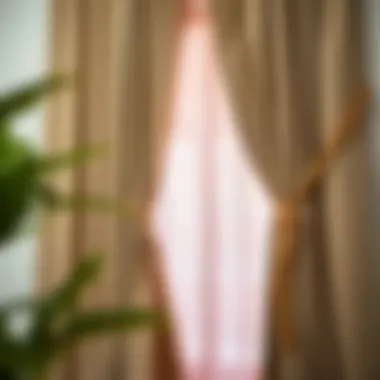
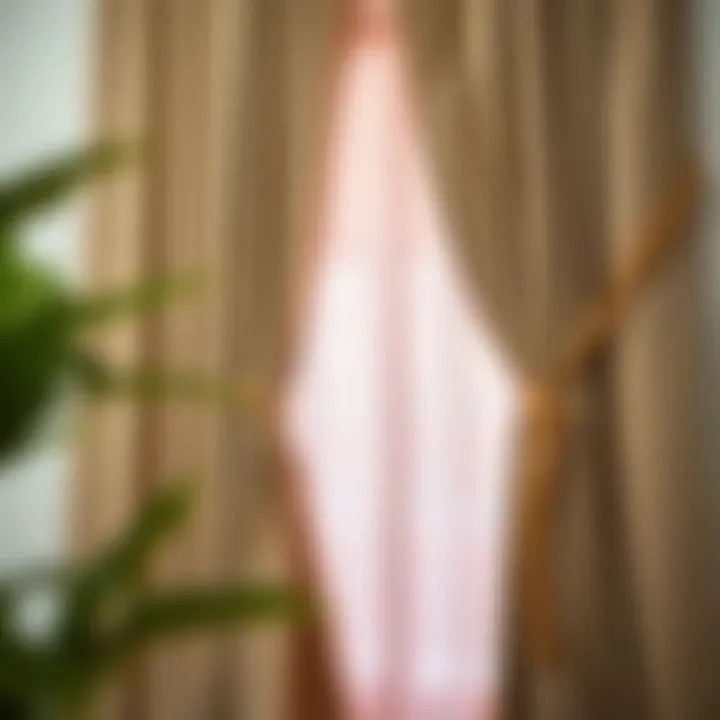
Integrating Rope-Tied Curtains into Interior Design
When it comes to integrating rope-tied curtains into interior design, the focus often centers on the harmonious blend of functionality and aesthetic appeal. Rope, typically associated with outdoor use or nautical themes, can metamorphose into a stylish accent in the right context. This dual role not only enhances the visual aspect but also introduces a unique texture that can elevate the overall decor of a room.
One of the key benefits of using rope to tie curtains is the versatility it offers. Whether you are going for a rustic farmhouse look or a sleek modern aesthetic, the choice of rope material and styling can speak volumes. The aesthetic quality of the rope can draw the eye and provide a point of interest. Depending on how it is utilized, it can either enhance the decor or act as a subtle complement.
Integrating rope-tied curtains is an art that transcends mere function, making way for creativity and personalization in home decor.
Color Coordination and Fabric Choices
Color coordination and fabric choices play crucial roles in determining how rope-tied curtains complement the overall interior. When selecting curtains, the fabric's texture and hue can enhance the effectiveness of the rope. For instance, lightweight fabrics such as sheer linens combined with natural fiber ropes create an inviting atmosphere. On the other hand, opting for darker fabrics like velvet with synthetic ropes can exude a more sophisticated vibe.
Moreover, it's smart to think about complementary colors. A soft beige curtain paired with a natural jute rope can evoke a serene, coastal feel, perfect for a beach house. In contrast, vivid, patterned fabrics can work beautifully when tied with robust nylon rope, adding energy and life to a room.
Key points to consider include:
- Fabric Weight: Lighter fabrics often pair better with softer ropes, while heavier fabrics can hold their own with thicker varieties.
- Color Palette: Ensure that the color of the rope doesn't clash with the curtains or surrounding decoration; a well-thought-out color scheme enhances the overall look.
- Texture Contrast: Mixing different textures can create a visually appealing outcome; therefore, combining smooth fabrics with rough rope can yield an interesting result.
Balancing Other Decor Elements
Balancing other decor elements with rope-tied curtains takes a bit of finesse. Once you've chosen your rope and fabric, the next step involves ensuring that these choices will jive well with the existing decor. It's essential to maintain a consistent theme; if your room has rustic wooden furniture, natural fiber ropes can create a cohesive look.
However, don't shy away from making bold choices, especially if you're aiming for an eclectic design. Rope-tied curtains can indeed stand out amid modern furnishings. Here, you might want to play with colors and patterns to contrast effectively with minimalist pieces.
To strike a balance:
- Evaluate existing color schemes; do the curtains harmonize or clash?
- Consider the overall texture in the space; ensure that the rope�’s texture matches or enhances surrounding pieces.
- Pay attention to the scale; larger ropes can dominate a scene, while delicate, thin ropes provide more subtlety.
By harmonizing these elements, you create a space that feels thoughtfully put together, where rope-tied curtains shine as both functional pieces and visual statements.
Sustainability and Ethical Considerations
Sustainability and ethical practices are becoming pivotal in contemporary home decor, notably in the choice of materials used in various applications. The discussion surrounding rope for tying curtains is no exception. As homeowners and designers increasingly recognize their environmental impact, understanding how sustainable materials and ethical sourcing come into play is critical. Incorporating eco-friendly ropes not only enhances aesthetic value but also aligns with a deeper commitment to environmental stewardship and ethical production.
Utilizing sustainable rope options can bring multiple benefits. First off, it contributes to reducing the carbon footprint associated with conventional rope materials. Traditional synthetic ropes often rely heavily on petroleum-based fibers. In contrast, natural fiber ropes, such as those made from jute or hemp, are not only biodegradable but also come from renewable resources. This means when they're disposed of, they won't linger for decades polluting the environment.
Furthermore, the production of eco-friendly ropes typically employs less harmful chemicals during the manufacturing process. This consideration is key for both health and environmental reasons. Choosing ropes that prioritize non-toxic dyes and treatments ensures that indoor air quality is not jeopardized. Homeowners and designers can rest easy knowing that their decor choices will not adversely affect their health or that of their loved ones.
Eco-Friendly Rope Options
When selecting rope for curtains, options that stand out for their sustainability include:
- Hemp Ropes: Sourced from the hemp plant, these ropes are strong and resistant to mold, making them ideal for various climates.
- Jute Ropes: Known for their softness and flexibility, jute is both biodegradable and compostable, lending itself well to eco-conscious design.
- Sisal Ropes: Derived from the Agave plant, sisal is durable and can withstand wear, adding rustic charm to any room. The process of harvesting sisal is also environmentally friendly, as it doesn't demand the use of chemicals.
Exploring these options creates an opportunity not just for functional, but also aesthetically pleasing finishes in curtain tying, marrying utility with a commitment to the environment.
Sustainable Practices in Home Decor
Beyond the choice of rope, sustainable practices in home decor are gaining traction. Here are some key practices to consider:
- Repurposing Materials: Using leftover materials or upcycling old items can minimize waste. For instance, old curtains or fabric scraps can pair beautifully with eco-friendly ropes, reducing the need for new fabrics.
- Choosing Local Suppliers: Sourcing materials locally reduces transportation emissions and supports local economies. This practice often ensures that the materials are fresher and may even be produced under more ethical conditions.
- Prioritizing Durability: Opting for high-quality materials that stand the test of time helps reduce the overall consumption of resources. By investing in durable decor items, designers can promote a culture of sustainability rather than disposable fashion.
"Adopting sustainable practices in home decor is the key to ensuring our living spaces are both beautiful and environmentally responsible."
Emphasizing sustainability is more than a trend; it reflects a collective consciousness that respects our planet and future generations. This is where the intersection of style and sustainability arises, urging designers and homeowners alike to rethink traditional methods and choose options that are as kind to the earth as they are to the eye.
Finale: The Enduring Appeal of Rope in Curtain Design
Rope as a means of tying curtains has stood the test of time, blending both function and form in a way that few other decor elements can. The versatility inherent in rope usage allows for a myriad of styles and techniques, making it an excellent choice for various interior designs. This article's exploration reveals that the enduring charm of rope lies not only in its practical benefits but also in its aesthetic contributions.
Key Elements and Benefits
- Versatility: Rope can easily complement a spectrum of design styles—from rustic farmhouse vibes to sleek urban aesthetics. Whether opting for jute for a casual look or nylon for a more polished finish, each material can offer a different visual impact while maintaining the practical aspect of holding curtains in place.
- Aesthetic Appeal: The texture and natural look of rope can significantly enhance a room's atmosphere. By incorporating decorative knots or unique tying techniques, one can create a focal point that draws attention and adds character to window treatments. For example, a simple loop at the top of a sheer curtain can transform an ordinary setup into something remarkable.
- Sustainability: In an era where eco-conscious choices are paramount, using natural fiber ropes can align with sustainable living principles. Choices like hemp or sisal not only reduce environmental footprints but also offer a warm, organic quality that synthetic materials might lack. The growing trend toward sustainable home decor showcases how rope can fit seamlessly into contemporary design modes without compromising ethical values.
Considerations
As interest in tying curtains with rope grows, it becomes crucial to consider the balance of aesthetics and functionality. The durability of rope plays a significant role in the long-term viability of such decor choices. Regular maintenance, as outlined in our previous sections, ensures that the ropes remain robust without sacrificing their charm. Furthermore, understanding safety, especially in homes with pets or small children, is important in ensuring that decorative elements do not become hazardous.
In the realm of interior design, constructing an identity through personalized touches like rope-tied curtains offers room for creativity while still addressing essential functional needs. By wisely selecting colors and materials that not only blend with existing decor but also elicit a personal touch, one can significantly enhance a living space.
"Rope is not merely a tool; it is a creative conduit that ties together functionality with personal expression."
Whether you are a designer looking to elevate a space or a homeowner seeking to refresh your environment, considering rope as a central element in curtain design could be the key to bringing your vision to life.



